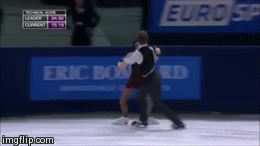Basic information on the key points and assignment of levels for the Finnstep can be found on pages 13 and 14 of the Handbook for Technical Panels 2013 with a more detailed discussion found within pages 16-20. Please see ISU Communication #1497 as well, found here.
And here are diagrams of the step patterns:
Man's steps
Lady's steps
Please see also the Handbook for Officials on Pattern Dances.
In accordance with the rules outlined by the ISU, this dance, which is based in ballroom quickstep, should be “fun, fast” and “light”, with “crisp and tidy timing as well as footwork”, with the accent at the beginning of the beat rather than just on the beat. This dance calls for erect (“very upright, almost stiff”) posture and a contrast between “the longer steps with strong, well rounded, deep edges” and “the crisp light steps, toe steps and hops (small jumps without rotation)” to fully express its character.
Below we have described what is going on in the key points. In Section II, key points 1 and 2 are based on the steps of the lady and man respectively, but they are happening simultaneously and the first step is the same for both partners so we included a description of what the team is doing as set-up for each of these key points to help you better identify the steps.
RFI=right forward inside edge
RFO= right forward outside edge
LFI=left forward inside edge
LFO= left forward outside edge
XF=cross step in front (below the skating knee)
XB= cross step behind (below the skating knee)
Tw=twizzle
Sw3=swing three turn
RBO3=three turn executed on a right back outside edge
Sw-ClCho=swing closed choctaw
XBClCho=closed choctaw with free foot crossed behind the skating foot (below the knee)
OpMo=open mohawk
Please refer to the previous entry for more information on turns and edges.
We have included gifs of the Finnstep pattern of Pechalat & Bourzat from Trophee Eric Bompard 2013 for which they received two level 4s.
Remember that levels are given for correct edges, turns and timing. Key Points 2 and 3 of the first section of the pattern happen simultaneously, thus one video is provided for both. This is also the case for Key Points 1 and 2 of the second section of the pattern.
Finnstep Section I
Key Point 1 Lady & Man Steps 1 & 4 (XB-RF, XB-LF) and Lady Step 12 (LFO Tw1½)
Each partner crosses the right foot behind the left for the first step and the left foot behind the right for the fourth step. For step 12, the lady enters on a left forward outside edge into 1.5 twizzles.
Key Point 2 Lady Steps 20-21 (XB-LBO, XF-RBI/RBI Tw1½/RFO)
The female partner crosses her left foot behind her right foot on a back outside edge and when this foot touches down she immediately picks up the right foot to cross it in front of her left foot on a back inside edge. Immediately following these steps, you see the female partner twizzle 1.5 rotations entering on that same right forward inside edge and exiting on a right forward outside edge.
Key Point 3 Man Steps 20-21 (XB-LFI, RFO-Sw3/RBI Tw1/RBI)
The male partner crosses his left leg behind his right on a forward inside edge and as soon as he gets on this edge he brings the right leg up and crosses in front of his left without touching the right foot down on the ice before moving it back to its regular alignment and setting it down on a forward outside edge. On this same forward outside edge, the male partner completes a swing three turn, exiting this turn on a back inside edge. This edge becomes the entry edge for the single twizzle that follows, and the male partner exits this twizzle on the same right back inside edge.
Finnstep Section II
Key Point 1 Lady Steps 32 & 33 (LFO Sw-ClCho, RBI/RBO/RBO Tw1½/RFI slide into stop)
The team comes out of the corner and both skaters get onto their left forward outside edges and swing their right legs forward and step onto right back inside edges (swing closed choctaw on left forward outside edge). The female partner then changes to a right back outside edge which is the entry edge for the 1.5 twizzle. She exits this twizzle on a right forward inside edge and slides to a halt on this edge.
Key Point 2 Man Steps 32 to 33c (LFO Sw-ClCho, RBI OpMo, LFI, RFI/RFI Tw1/RFI slide into stop)
The team comes out of the corner and both skaters get onto their left forward outside edges and swing their right legs forward and step onto right back inside edges (swing closed choctaw on left forward outside edge). The male partner then performs an open mohawk on this same right back inside edge, bringing the left foot in front of his right and placing that left foot on a forward inside edge. He then steps onto his right forward inside edge and performs a single twizzle, exiting on a right forward inside edge and sliding to a halt on this edge.
This step is performed in the corner. They glide on their left forward inside edges and bring their right legs behind their left and cross the right foot behind the left foot on a back outside edge (LFI XBClCho). On this same right back outside edge they each perform a three turn with the free leg extended. They then bring the free leg in for the twizzle of 1.5 rotations.
Some brief notes on quality: Note how crisp and clean Pechalat/Bourzat's edges are throughout this dance. There is very little snow flying up from their blades. Note also how strong their posture is and how close together they skate this pattern, with excellent unison and good ice coverage. This was a strong Finnstep all around.




















